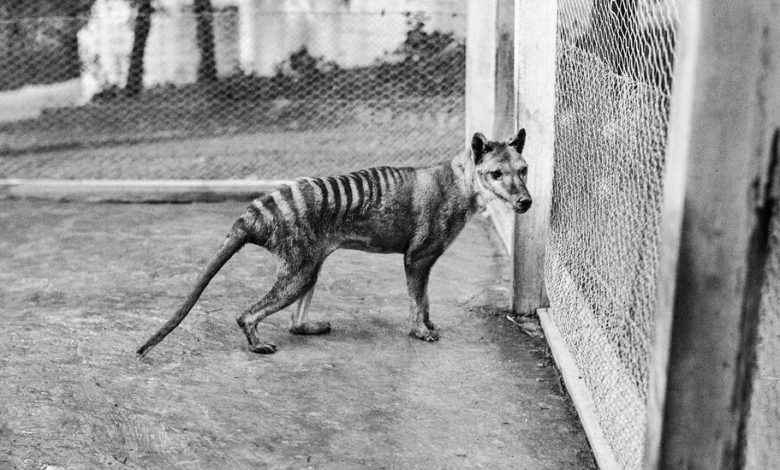New Support for Some Extinct Tasmanian Tiger Sightings

Depending on whom you ask, the Tasmanian tiger or thylacine has either been extinct for nearly a century or has been just really good at hiding.
Now new research examining hundreds of reports from more than a century shows there is a good chance the thylacine may have persisted for a few decades longer in the most remote parts of Tasmania.
“There are pockets where the species could have maintained small populations,” said Barry Brook, a professor of environmental sustainability at the University of Tasmania.
One of the problems with the thylacine, and extinction in general, is it’s hard to prove something is truly gone. Australia’s night parrot for instance, was thought to be extinct for 140 years until its recent rediscovery.
The last known thylacine was given to Hobart Zoo in Tasmania in 1931, dying in captivity in 1936. European settlers, some of whom harbored mostly unwarranted fears that the animal would attack livestock, relentlessly hunted the striped, carnivorous marsupials, which resembled wolves more than felines. The Tasmanian government even offered bounties on the thylacines. By the early 1900s, the population had crashed, Dr. Brook said.
More on Australia
- Standing Up for Democracy: In the 1850s, a Black man was put on trial for leading a miners’ rebellion in Australia seeking less taxation and more representation. His legacy was forgotten — until now.
- Keeping an Old Tradition Alive: Two sisters are among the dwindling few in the country who gather family and friends once a year to make passata, a tomato purée that is a staple of Italian cuisine.
- Protecting Melbourne’s Bats: A sprinkler system in Yarra Bend Park will help gray-headed flying foxes stay cool during dangerous heat waves.
- A River Choking on Fish Corpses: Millions of fish have died in the Darling River in New South Wales. Furious locals say the root of the problem is the overuse of Australia’s biggest and most vital river system.
But cryptozoologists, hikers and even the occasional hunter or park ranger have reported thylacine sightings for decades after the animal’s presumed extinction in Tasmania, driving speculation about whether 1936 “was the final death knell of the species, or did it hang on,” Dr. Brook said.
He and his colleagues decided to take a statistical approach, combining all the reports they could gather and rating them in terms of reliability to improve their understanding of when and where the thylacine might have gone extinct.
For a study published last month in the journal Science of the Total Environment, Dr. Brook’s team studied 1,237 Tasmanian tiger reports from 1910 onward. It classified these reports in terms of credibility. More than half of the reports came from the general public. The team also found spikes of sightings that were probably linked to high-profile thylacine news in Australia — what Dr. Brook’s team called “recency bias.”
Some reports between 1910 and 1937 were of confirmed captures or kills, with the last fully wild photographed kill occurring in 1930. Dr. Brook’s team considered another four reports of kills and captures/releases from 1933-1937 legitimate.
For the following eight decades, 26 deaths and 16 captures were reported but not verified, as were 271 reports made by people that Dr. Brook’s team considered experts: former trappers, outdoorsmen, scientists or officials. These types of high-quality reports from experts peaked in the 1930s and started to fall in the 1940s.
People who had definitely trapped or seen thylacines before the 1930s, and who presumably knew what they were looking at, had either died or retired by the 1970s. “That whole pool of expertise kind of dries up by the 1970s,” Dr. Brook said.
The best quality report after that, he said, came from a park officer who saw one in 1982. A model based on all these reports reveals Tasmanian tigers likely went extinct between the 1940s and 1970s, with a smaller chance they persisted in remote areas until the 1980s or even the early 2000s.
Branden Holmes, an independent conservationist and editor of the recent book “Thylacine: The History, Ecology and Loss of the Tasmanian Tiger,”and who was not involved in Dr. Brook’s study,called the research “a laudable attempt to find out when and where the thylacine likely went extinct,” using a large data set of reports. “The last members of a species are invariably (almost) never seen by humans, particularly on an island as large and sparsely populated as Tasmania,” Mr. Holmes said in an email.
But he noted that not everyone may agree with the quality rating of some of the reports the team analyzed.
Nick Mooney, who studied Tasmanian wildlife for decades and who also wasn’t involved in Dr. Brook’s study, put it another way: “You have court cases without any witnesses, just scraps of reports written down by other people.”
Mr. Mooney has interviewed hundreds of people who reported thylacines. He found that most either misidentified the creature they saw, lied or were delusional — and that a psychological effect or modified memory might be to blame in some cases.
At the same time, Mr. Mooney finds the 1982 report by a park officer relatively credible. “I don’t disagree with the authors, except to say their conclusions are somewhat optimistic, considering the material used,” he said.
Dr. Brook’s analysis found there to be a very small chance that the thylacine is still around today. For that possibility, Mr. Mooney said that even if Tasmanian tigers did persist past 1936, the likelihood of their still being around shrinks all the time. Someone should have found one by now, given the high levels of roadkill in Tasmania and the increasing use of trail cameras in more remote parts.
Dr. Brook agrees that we’re unlikely to discover surviving thylacines.
“The hope for some people is that the thylacine is a Lazarus species that will rise from its tomb and walk again,” he said, “but that unfortunately hasn’t happened.”




